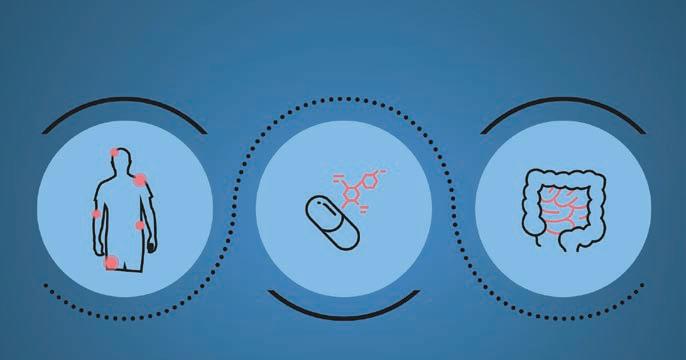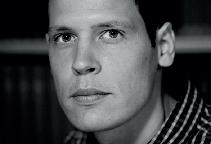
10 minute read
Highlights from the 35th NCDV 2022 / Line
Highlights from the 35th NCDV 2022
At NCDV 2022, Nordic and Baltic dermatologists came together to share the newest research and discuss hot topics. In this summary of events, Dr. Line Kibsgaard offers an overview of the 35th congress.
LINE KIBSGAARD is MD and Ph.D. at the Department of Dermatovenereology, Aarhus University Hospital, Denmark. Her special interests include venereology, urticaria and hidrosadenitis suppurativa.
Dear colleagues,
It is my absolute pleasure to share my observations from the 35th Nordic Congress of Dermato-venereology. So, lean back and enjoy my journey through this congress, which I hope will give you a picture of some of the highlights of special interest to you.
The venue was the beautiful Tivoli Hotel in the centre of Copenhagen. The pre-programme started on April 19 with on-site board-meetings and an evening Network Event, hosted by the LEO Foundation as proud presenters of the new and visionary Skin Immunology Research Centre at the Maersk Tower in Copenhagen. The centre has collected biomaterials from 3,000 patients which will yield insights into how skin diseases develop over time.
Day 1: Psoriasis, AD, and chronic urticaria
On Wednesday, April 20, the official programme started with the General assembly meeting of the Danish Dermatological Society (DDS). The chair position of DDS changed. Christian Vestergaard, Aarhus University Hospital is succeeded by Simon Francis Thomsen, Bispebjerg Hospital. Kristina Ibler, Bispebjerg Hospital becomes treasurer. The autumn meeting of DDS will be held in Aarhus on November 4-5 in a new and exciting format. All members are more than welcome to join.
Understanding and treating itch Afternoon plenary sessions were split into parallel sessions on the two major chronic skin diseases: Psoriasis and Atopic Dermatitis (AD). Each session had excellent speakers from across the Nordic countries. The “itch session” held by Jesper Elberling, Gentofte Hospital, was quite an audience attracter, as he manages to share his enthusiasm for getting to grips with the pathogenesis of itch.
Itch is one of the most frustrating parameters in treating patients with AD. It’s frustrating for the patient and family members, and often also for the physician who tries to resolve the serious issues of their patient’s disease.
One of my favourite learnings as a junior dermatologist was the fact that itch sensations differ significantly between patients with AD compared to patients with urticaria. This is easy to see in our clinics, as AD is often plastered by secondary excoriations, which is almost never seen in patients suffering from urticaria. In AD, itch is an inflammatory signal and part of the cascade of immunological reactions from the patient’s skin, which seeks to get rid of the sensation by initiating a mechanical action in the form of scratch. The efferent sensation is led by the epidermal non-myelinated polymodal C-fibres. The afferent mechanism is led by motor neurons that innovate and activate muscle contractions to achieve relief from itch. Itch is a sensation that is rewarded with increased levels of oxytocin in the postsynaptic nerve endings of the CNS.
In addition, functional MRI studies of itch have shown repeated activity in specific areas in the cerebral cortex. This can be imaged faster/earlier than when the patient recognizes the visual signs of dermatitis on their skin. Hence, itch in AD should be referred to as an inflammatory, and even more important, non-histaminerge itch. In contrast, in urticaria the itch sensation is a consequence of the rapid release of antihistamines and prostaglandins from epidermal mast cells. It is merely a consequence of the human innate immune response. In AD patients, JAK inhibitors
and dupilumab (anti-IL13/anti-IL4) are first-line biologics; if using systemic anti-inflammatory treatments (MTX, azathioprine, or cyclosporine) does not afford acceptable disease control.
Biologics targeting chronic urticaria Simon Francis Thomsen, Bispebjerg Hospital, elegantly followed up on this topic with his presentation of future targets for treatment in chronic urticaria patients (CSU) who do not respond or have a slow or insufficient response to omalizumab (type IIb CSU patients). In about 15% of all CSU patients, blockage of the FRI receptor is not sufficient to relieve symptoms. Small molecule treatments (cytokine and tyrosine kinase inhibitors) may be the answer in the future for this patient group, along with ligelizumab (anti-IgE), benralizumab (anti-IL5), and mepolizumab (anti-IL5). Hence, the future holds promise for the Xolair non- or insufficient responders, who may be suspected in cases with positive basophile histamine release tests and low levels of basophils, eosinophils, and total IgE.
In the following parallel sessions, some of the leading Nordic experts in AD and psoriasis gave presentations on comorbidities, pathogenesis, and treatment strategies. Patient-reported outcomes were an emerging topic of interest, along with EASI scores that are about to match the reported scores of PASI, for example EASI-50, EASI75 and EASI-90.
Highlighting our international landmarks At a late-afternoon session on Wednesday, representatives from Sweden, Norway, Iceland, Finland, the Baltic countries and Denmark were each invited to give a talk on their respective nations’ global contributions to Dermato-venereology. This inspired a wide range of topics: famous Nordic dermatologists and venereologists from the 19th and 20th centuries, highlights of cohort-studies on syphilis from Norway and Sweden, the Norwegian contemplation of the Hanifin-Rajka criteria from 1979, the Danish Nobel prize winner from 1903, Niels Finsen, who was the inventor of light therapy, highlights of the Baltic congresses of Dermato-venereology over the years, and finally the Icelandic “Keresis´adventure”; A very fine presentation of the world’s 5th largest deliverers of skin transplants evolved from a fish skin model.
All attending nationalities were – in a very unNordic manner – encouraged to be proud of their fellow Dermato-venereologists’ achievements throughout history. This was, in my opinion, the most entertaining session of the whole congress.
Day 2: HS, hot topics
The future of treatment in HS and biologics Thursday morning set off with a session on Hidradenitis Suppurativa (HS), focusing on the worldwide epidemiology, treatment challenges, bio-eligibility, DLQI and when to consider surgery for this group of patients, and future recommendations yet to come. According to the upcoming revision of the European guidelines, we will distinguish between active and inactive inflammatory disease, and measure disease activity according to the IHS4-scoring system, in which the number of nodules, abscesses, and draining fistulas are all considered.
Clinical trials have shown equal response to Doxycycline and the Clindamycin-plus-Rifampicin regimes. This gives us hope to offer biologic treatments (anti-TNF α) much earlier than before, combined with the increasing knowledge and interests in biological treatments of patients with HCS, where secukinumab (anti IL17), bimekizumab (anti IL17A/F), spesolimab (anti-IL36) and JAK pathway inhibitors are under investigation.
For people with a special interest in HS, the speakers were proud to announce the dates of the upcoming 2023 Conference of the European HAS-society, which will be held February 8-10 in Florence.
Hot topics in Nordic dermatology Parallel to the morning session on Thursday was a brilliant pros-and-cons session on the themes of 1) Melanoma screening and 2) Emollients, both ongoing subjects of debate among patients, colleagues, and from a pharmaceutical and socioeconomic point of view, where it seems as if there are no uniform or final conclusions.
Other topics of interest were skin infections (COVID-19 skin manifestations), melanomas, work-related eczemas, and the increasing use of artificial intelligence in our daily work practice as dermatologists.
When it comes to future infections within our specialty, our concerns should not be limited to meat-eating bacteria and resistant staphylococci; a general phenomenon in the Nordic countries is the rising prevalence of sexually transmitted diseases. In Denmark, the incidence of gonorrhea and syphilis are at their highest
levels in 20 years, and it seems as if this is a trend that is not going to decrease without national interventions. Thus, it was very comforting to hear the talk of Usha Hartgill from Norway, who has done important research on gonorrhea that gives us hope that a future vaccine against gonorrhea may become realistic.
Young colleagues sharing new ideas The Poster Walk on Thursday afternoon was converted into short presentations of studies by some of our younger colleagues, who shared their enthusiastic and clever ideas. For me, this was the most inspiring moment of the congress, as it is in forums like these ideas come to life and the finest core of research becomes visible to everyone.
Thursday night, the congress dinner was held at the Langelinie Pavilion next to the Little Mermaid. We arrived by boat, and Copenhagen showed itself from its most beautiful and sunny side. Ideas and inspiring moments continued to be shared while glasses were raised in celebration of finally being able to meet faceto-face after two years of COVID-19-lockdown.
Microbiomes, rosacea, acne, and trends in psoriasis research were the topics on Friday morning in parallel with the second and well visited nurse section. It was a pleasure to observe how specialized dermatological care issues were shared and discussed on a highly competent level, where I am sure that we can all gain priceless experiences, if we dare to share our personal stories of success and flaws with our neighboring countries who must face similar challenges, when it comes to socioeconomic, geographical and political issues within our field of expertise.
Free communication and poster awards The final sessions of the congress were two free communication sessions, where ten projects were presented by the conducting scientists with the opportunity to discuss methodology and future perspectives of their ideas. The ten most remarkable posters were selected in several categories, from the most original idea (how to wash your socks to avoid fungal infections) to the most educational poster (Systematic review on Prurigo Nodularis Hyde) assessed by the congress committee members.
Bright future for treatment of dermatological conditions In conclusion, the Congress left a great deal of joy and excitement among attendees about finally being able to meet again. We were able to share our common passion to treat, comfort, and relieve itch, sores, and the various agonies of our dermatological patients. There is no doubt that we are about to face an explosion of possible treatment strategies when treating AD patients with biologics, an explosion that is similar to the one psoriasis treatment has gone through during the last decade or two, and where EASI-90 is a realistic treatment goal in the future to come.
Lots of antibody and small molecule treatments are on their way, and I have high expectations for the future medical care of HS, urticaria, and AD patients, in particular. I think that multidisciplinary approaches are going to be the future “new black”, not only in treating cases of psoriasis, dermatological cancer patients, and wound-care but also in the treatment of AD-, urticaria- and HS-patients. These are disease areas where initial multidisciplinary expert assessments may turn out to be the most cost-beneficial model from a long-term perspective and a way to plan treatment courses, which can be maintained by our excellent collaborators in the primary health care sector. From a patient perspective: A way to receive expert assessments in one setting with close and expert follow up until complete disease control, where-after patients may again gain from the undebatable advantages offered by the primary health care sector.
I would like to thank the organizing committee of this wonderful congress. For all of you who could not join us, I hereby give my warmest recommendations. I sincerely hope to meet you all at the next congress.
With best wishes
MD, Ph.D. Line Kibsgaard Department of Dermatovenereology Aarhus University Hospital, Denmark.
CONFLICT OF INTEREST:Speaker at a LEO Pharma industrial symposium. Attendee at congress, sponsored by UCB. Attendee at symposium hosted by Eli Lilly. Attendee at symposium hosted by Abbvie.
Tag på online kursus når du har tid
• Kurser udviklet efter gældende guidelines • Du har adgang til hele kurset i 1 år
Et kursus for dermatologer, KBU-læger, introlæger og HU-læger

• Grundlæggende forståelse af immunsystemet • Immunologiske mekanismer bag flere autoimmune sygdomme, forskelle og ligheder • Immunologi, farmakokinetik, bivirkninger og montorering samt forholdsregler og graviditet • Blended learning med tekst, animationer og videoer • Tager i alt ca. 2-3 timer at gennemføre, inkl. faglig test • Pris kr. 2.500 ekskl. moms – så har du adgang i 1 år










